|
|
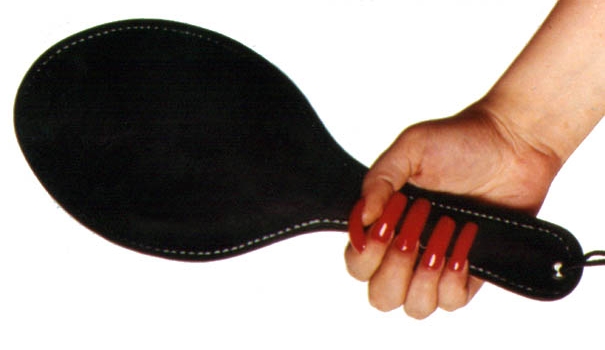
Oval leather paddle - perhaps the best type of paddle ever made.
|
Selecting a Paddle with the Proper Shape
Paddles have been made in many different shapes (and sizes). However, there are only two that conform
reasonably well to the shape of the target area, namely the oval and the rectangular.
Examples of the oval type are the common leather one, which is probably he easiest and safest type
of paddle to use, and the less common platform tennis paddle, which offers the greatest control
among types of heavy (1/2" thick) wooden paddles.
|
|
|
|
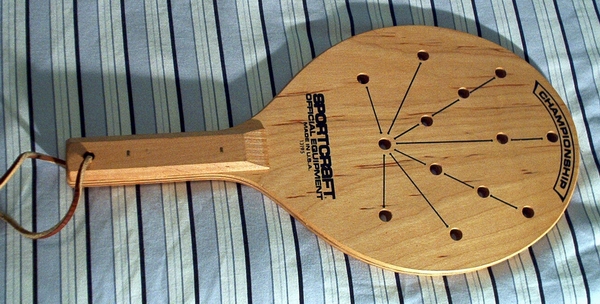
|
Platform tennis paddle. Somewhat shorter in length than the fraternity paddle and with a comfort-grip
handle, it is the easiest piece of "heavy artillery" (1/2" thick paddles) to control. In general, I
recommend you use a paddle without holes, but platform tennis paddles always have them and these are
small enough not to cause trouble.
|
|
|
|

|
Medium-sized rectangular paddle, 15” overall length, 3” wide, 3/8” thick. The "little brother" of the
fraternity paddle, this one is both easier
to use and less likely to bruise - my favorite of all the wooden paddles. Note that even when the far
edge is curved and not straight, we will still place the paddle in the "rectangular" category even though
that isn't quite correct geometrically speaking.
|
|
|
|
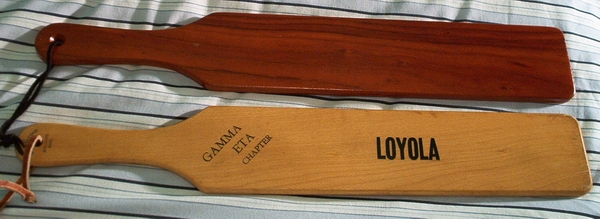
|
The classic fraternity/sorority paddle, 22" long by 3 1/2" wide by 1/2" thick. MUST be used with
restraint, a point to which we'll return later, but still a useful addition to the paddler's collection,
if only to make the spankee feel relieved to get paddled with another implement! Rectangular paddles
should be 3" to 3 1/2" wide, with 4" being a realistic maximum for special cases. Wider ones have been
built, but they tend to cause problems such as striking the tops of the thighs because nobody's behind
is that big (let's hope!).
|
|
|
|
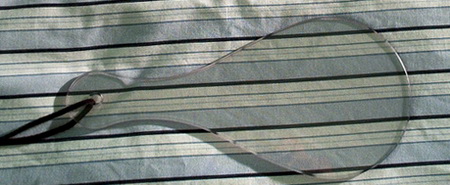
|
The classic paddle-ball paddle, here made out of unbreakable lexan rather than the traditional wood.
You could take the string and ball off an actual children's toy, but those are too light to
sting enough for a good spanking. Works very well for OTK action.
|
|
|
|

|
Short leather paddle. The key feature here is the short length, which makes it good for OTK use, rather
than the material.
|
|
|
|
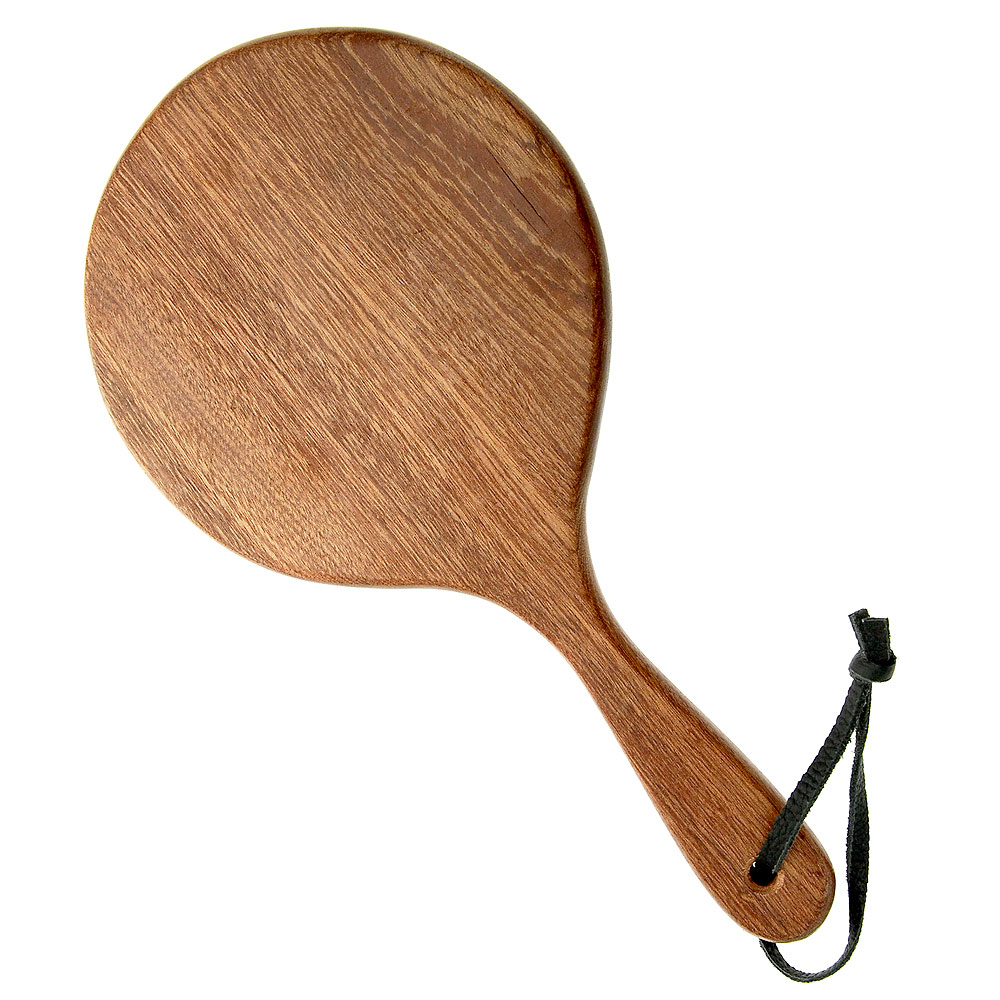
|
Round paddle. A bad shape because it's always too wide in proportion to its length. With a short-enough
handle, it could be used OTK, but even there you'd be better off with the paddle-ball style or a hairbrush.
|
|
|
|
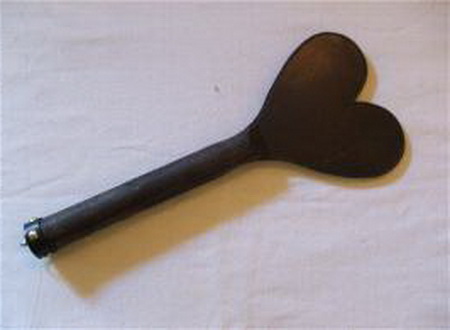
|
Heart-shaped paddle. These turn up now and again, but apart from being too cutesie-poo for my tastes
they share with the round paddle the disadvantage of being too wide. They could be used in the
"spanking machine position" where the spankee gets down on hands and knees and the paddler straddles
her facing rearward and applies the paddle with a downward, between the (paddler's) legs stroke, because
this turns "width" into "length", but that would be awkward and tiring.
|
|
|
|
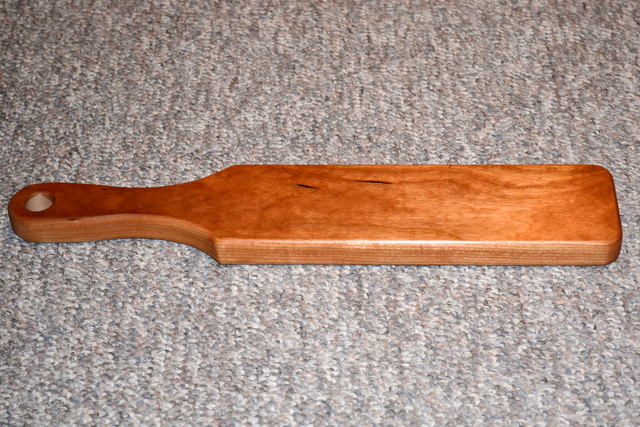
A beautifully finished 3/4" inch model, from
SpankingPaddles R Us. Nice as it looks,
I'd still say 1/2" is better.
|
Not too thin, not too thick:
Wooden paddles used in U.S. schools or in fraternities/sororities such as the ones shown above are
traditionally 1/2" thick. This thickness is certainly usable, but these implements must be classified as heavy
and must be used with restraint - full-force swats will cause extensive bruising and will definitely make
the experience very unpleasant for the spankee. I consider anything thicker than 1/2" to be
excessive, unless you're paddling a rhinocerous. 3/4" is full board thickness, but apart from its
easy availability in lumber yards there simply isn't any good reason to make a paddle that thick.
|
|
|
|
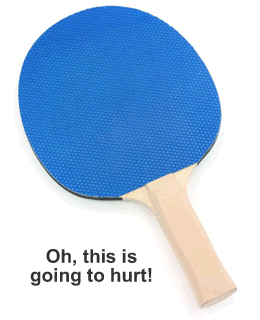
Typical ping-pong paddle. It won't hurt enough.
|
Ping-pong paddles sometimes get used in playful spankings because they're commonly available in the
"vanilla" world, but they're really not very well-suited for spanking because the handle is a little
too short even for OTK use, at least if the paddle is to be applied to the center of the target, and
they're typically too light to give much sting. The usual thickness is
1/4" or even less, which is enough for swatting a ping-pong ball, but just barely enough for spanking,
and not in a ping-pong paddle shape. Paddles this thin are also very subject to breakage.
For most purposes, I prefer a 5/16" - 3/8" paddle, which is right in between 1/4" and 1/2". Typical
hardwoods such as Maple, Birch, and Ash are strong enough at this thickness not to break, and they
give a very definite sting with light to moderate force without tending to bruise too much.
In summary, wood paddles should adhere to these thickness guidelines: 1/4" minimum, 1/2" maximum,
3/8" optimal.
|
|
|
|

|
Lexan is unbreakable, but denser than wood. Therefore the only thickness I can recommend is 1/4".
Despite this high density, lexan has a slight flexibility that wood lacks. In theory, this could
make it more forgiving than wood, but I must say none of my spankees has ever told me she preferred
to get the lexan instead of the wood!
|
|
|
|

|
Leather has much more flexibility than either wood or lexan, and for that reason is somewhat more
forgiving of the slight azimuth errors that the paddler inevitably makes (see the article cited above for
more information on alignment problems when paddling). Because making a leather paddle isn't
too much different from making other leather items (except for the stiffener that's often incorporated into
paddles), it's unlikely that a skilled leather craftsman will produce a paddle that's either too thick
or too thin. However, you should view leather paddles in terms of their weight and plan accordingly.
Heavy leather paddles, like thick wood paddles, will have more tendency to bruise than lighter ones.
|
|
|
|
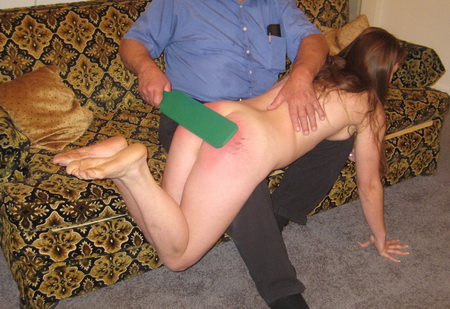
OTK is the king of all spanking positions, but it does not work well with long paddles.
Photo courtesy of Spanked Coeds.
|
3. Suit the position to the paddle and the paddle to the position.
Some spankos love a particular position, for instance OTK. Others love particular implements, such as
their cherished fraternity paddle from the 1940's. Both of these things are fine unless you try to
combine them and use your 22" fraternity paddle in the OTK position, which is never going to work right.
Let's see why.
|
|
|
|
In the OTK position, the spankee is necessarily very close to the spanker's body. This means that only
short paddles (12" maximum length) can be comfortably used - 15" is really pushing it, and 22" guarantees
trouble. The spanker pictured here is doing remarkably well - he recognizes that he has to pull his arm
way back because of the 22" length of the paddle he is using. But this is an awkward, tiring position,
and in addition will invariably tend to azimuth misalignment (right side getting paddled more than the
left) because his arm must be kept relatively high above the spankee.
|
|
|
|

Ready for paddling! I'm not sure, but this one may have come from
Jules Jordan.
|
If you really love using paddles over about 12" long, then the bending-over positions are for you.
(I use the plural here because there are so many variations of this position). The great advantage of
bending over is that the paddler can easily adjust his position to match the length of his paddle -
with shorter paddles, stand closer to the spankee, with longer paddles, stand further away. This is
impossible with OTK. There are of course potential problems with this position, and they are discussed
in the next section below.
Two other positions, standing and prone (e.g. lying face down on a bed) turn up
now and again in spanking play, but neither works well with paddles of any length. The problem with
the standing position is that the spankee will be able to clench her buttocks, which is sort of instinctive
but only makes things worse for her. Besides, you lose the psychological advantages of making her
"assume the position". The prone position takes the same azimuth alignment problem you have using
long paddles in the OTK position and makes them much worse. This is so because the paddler's shoulder
is far above the spankee's bottom, unless the paddler is some sort of midget! If the spankee really
wants the prone position, and some do because of having experienced it during childhood, then use a
flexible implement such as a belt or strap.
|
|
|
|
To summarize: use short paddles (maximum length 12") in the OTK position; use medium (13" - 14") and
long (15" and up) paddles in the bending over positions. Do not use paddles with the standing or
prone positions.
|
|
|
|
4. Common Positional Mistakes and How to Correct Them
I don't want to go through the OTK position again here because I think most people understand how to do
it, and other articles deal adequately with this topic. Most problems occur with the bending-over positions.
There are two kinds of positional errors that frequently occur when paddling, those involving the paddler
and those involving the spankee. First let's talk about the spankee.
|
|
|
|
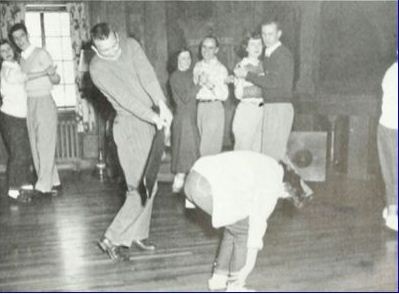
Believed to be from a University of Iowa Paddle Party in 1951, this shot is a perfect illustration of
bad paddling: with the spankee's knees bent, there's no way the paddler can apply the paddle squarely
on target, and as you can see, he's way off. Also, this paddle is much too wide (it looks to be
between 5 and 6 inches). I've lost track of where I found this one, but the largest collection of
vintage sorority paddling pictures I know about is at
Windsor's Sorority Spankings.
|
The single most important point to remember is that THE KNEES MUST BE KEPT STRAIGHT. This is not a
matter of opinion, it's the only way to do things. Bending the knees causes the hips to angle downwards,
meaning that the paddler would have to apply the paddle at the precise upward angle to compensate and avoid
tilt misalignment. With the knees straight, all the paddler has to do is keep the paddle's flat
side vertical and the stroke level, and tilt misalignment becomes impossible. (Again, for a
thorough discussion of all types of paddle misalignment that may occur, see my article
How to Paddle, Strap, and Cane).
|
|
|
|
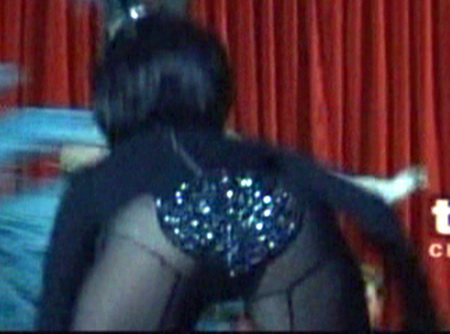
"Look straight ahead...!" The director of this movie was obviously a bottom-fancier and provided us
with several gratuitous shots of the female derriere. In this scene, the camera follows a particular chorine
(the one with the best rear end, one supposes) as she bends over, carefully keeping her head up to "stick
it out" as far as she could. No paddling here, but it does illustrate the concept of the arched back.
|
Although not quite as important as keeping the knees straight, I feel very strongly that the spankee must
be made to arch her back as much as possible. If you're not sure what this is
supposed to look like, try out the hands-on-knees position, which automatically tends to arch the back
(one of the points in its favor). This is normally done by making her raise her head and
shoulders with such commands as "Look up", "Look straight ahead" etc. which will work quite well
in all variations of the bending-over position except for holding ankles/touching toes, where only
flexible spankees can really manage it. Even there, they should be made to arch the back to the extent
possible without making them strain too much.
|
|
|
|
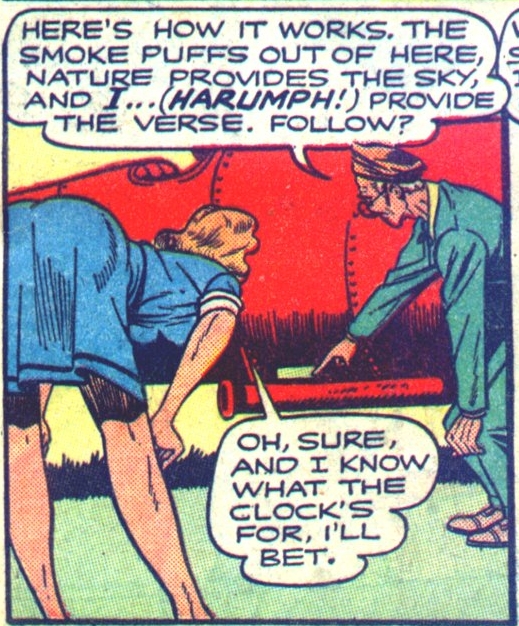
|
Much like the director whose preferred choreography we sampled above, the artists on Skygirl (this
panel looks like Matt Baker) may not have been spankos, but they sure understood the value of the
arched back in presenting the derriere! Ginger McGuire is here pictured in almost perfect hand-on-knees
paddling position with her head (and consequently her rear end) raised as high as possible. (For
more scenes where Ginger gratuitously "assumes the position", see our
Skygirl Special Feature).
Why is the arched back so important? First, it gives an attractive line to the body, as should be
apparent from these two illustrations. Second, it turns the bottom up to provide the best possible
target for the paddle. Third, it enhances the spankee's humiliation to make her "stick it out" whether
or not those actual words are used. Humiliating the spankee is very important in all but the most purely
sensual spankings.
|
|
|
|
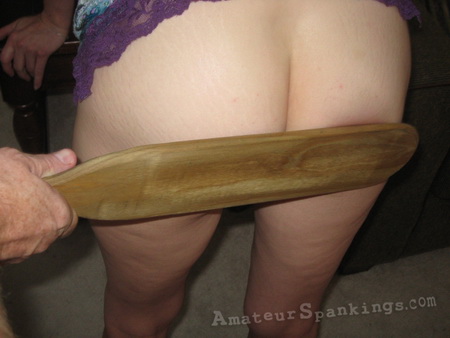
Photo courtesy of Amateur Spankings.
|
There are also many potential problems with the position of the paddler. Let's confine ourselves here
to the correct placement of the feet. Assuming a right-handed paddler, his left foot should be
in front of the spankee's feet. Many times the paddler stands too far back, causing
azimuth misalignment, which means that one end of the paddle (usually the far end) makes contact
before the near end, resulting in the spankee getting more on the right side than the left.
Although you can't see the paddler's feet here, you can see that the paddle is angled with the far end
closer to the spankee than the near end - in fact, you can see that the far end is already in contact.
This appears to have been a practice swing; when I checked out the video I found the paddler was
actually applying the paddle squarely on target, so he must have corrected his foot position.
|
|
|
|
5. Paddling the behind isn't like hitting a baseball, so don't use a baseball swing.
Perhaps we shouldn't be surprised that the "baseball swing" is often used with long paddles -
to the inexperienced paddler, handed the implement for the first time, it might seem perfectly
natural. But a little thought should convince us that we need a better approach when we consider that
(1) we don't need or want to use full force when paddling the way we would when "swinging for the fences";
and (2) baseball bats are shaped very differently than paddles. Let's see a short video now of a
bad paddling using the baseball swing.
|
|
|
|
The player above should work with most browsers, or download the
Windows Media version here. To download, right-click
and then select "Save Target As".
|
Much of the paddling that still goes on in this day and age takes place in college. The problem is that
college kids don't know any more about paddling than they do about anything else, and what's worse, they
don't know how little they know. We see a perfect example of that here.
The situation appears to be a college party where one brave girl volunteered to take a couple of swats
from another girl. She obviously had a high pain tolerance, which inspired some guy to see if he could
get more of a reaction from her by concentrating on delivering three very hard swats. I slowed this down
to 1/8 normal speed but it's still hard to follow everything that goes wrong.
|
|
|
|
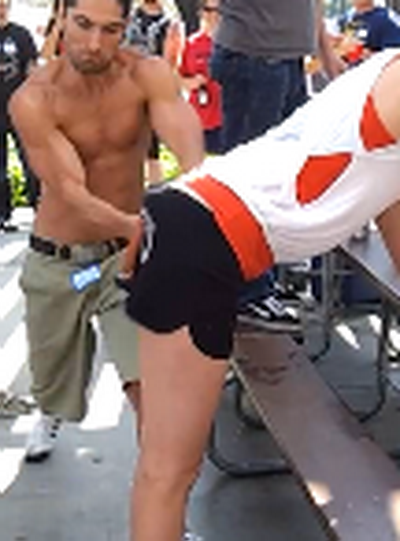
Bad swat #2, still frame #1.
|
As mentioned above, 1/2" paddles are potent implements, wonderful in their way
but requiring restraint in their use. We may charitably suppose that Shirtless Joe here meant no
real harm, but using as much force as he did was way out of line. I have paddled many women, and I
can tell you that even when delivering an unusually hard swat I've never needed to use more than 50%
of the force I could generate with one hand (female paddlers can obviously use more of their strength).
Shirtless Joe didn't think carefully enough about the difference between driving the ball out of the park
and giving a young woman a good, stinging (but not brutal) swat. She had an incredible pain
tolerance, but even so she must have been badly bruised. This is swat #2, and is actually his
least-incompetent attempt, but the baseball swing also invites other problems, as we'll see. When
I see something like this, I'm glad I've escaped the ignorance of youth, although there are times when
I'd like my hair back.
|
|
|
|
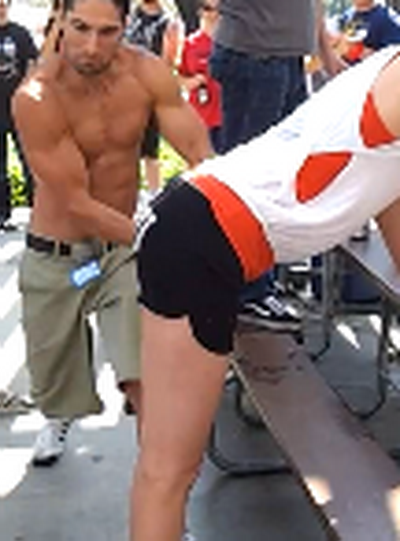
Bad swat #2, still frame #2.
|
Apart from encouraging the paddler to swing too hard, the baseball swing tends to rotate the paddle.
With a baseball bat, this isn't a problem because the shape of its surface is what could technically
be called invariant with respect to rotation about its long axis. This is a fancy way of saying that
a baseball bat doesn't change its effective shape when you rotate it. But a paddle does, and since we
want the flat face to be exactly vertical at the moment of impact, we would have to compensate for the
rotation by tilting it the same number of degrees in the opposite direction as it will rotate during the
swing, which as you can probably guess from the description is next to impossible.
In the still frame above it's hard to tell, but I believe the top edge of the paddle is rotated forward
of true vertical. Even if the paddle is vertical, it would only be pure luck. Does it matter? One
thing you'll learn about paddling from experience - small changes in the stroke can make a big difference to
the spankee - so yes, it matters!
|
|
|
|
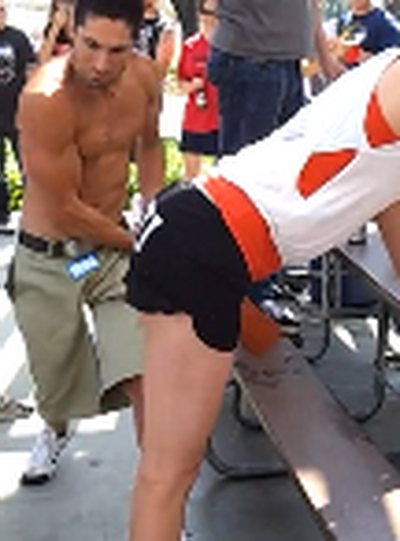
Bad swat #2, still frame #3.
|
Shirtless Joe takes a very long stride towards "home plate" also, but we'll let his hitting instructor
worry about that - he's got still another problem, namely azimuth misalignment. You can't see it in frame #1,
but in frame #2 you'll note that the paddle seemed to disappear entirely instead of coming to rest against
the spankee's bottom. Here in frame #3 it's back in view, but way over to her left -
he must have pulled the paddle so hard it bounced off her bottom and kept on going! This guy is obviously
a pull-hitter, which is o.k. in baseball but here means he simply didn't have sufficient control of the
implement.
The solution to these problems is to use a one-handed grip on the paddle - note that the handle's length
is right for one hand, not two. The left hand may be placed at the spankee's waist which will help
steady the aim. Hold the paddle in your right hand, keeping the flat faces exactly vertical.
A nice level stroke, at considerably less than full force (even with one hand), will get the job done.
It is possible to use a two-handed grip if you feel you must - start with the paddle exactly
where it's supposed to end up, then pull it straight back keeping the flat faces perfectly vertical.
Do not raise the paddle up over your shoulder as if it were a baseball bat!
To give the swat, simply reverse this motion. One of the waitresses at the Hofbrauhaus in Las Vegas
seems to employ this method, and I verified myself that it will work by taking a few trial swings
with one of my 22" paddles. I still prefer the one-handed grip, however.
|
|
|
|
Some women may have trouble using a one-handed grip with a 22" fraternity/sorority paddle because
the combination of weight and length puts a strain on the wrist (men should have no difficulty
in handling it). For these female paddlers the best advice would be to use a shorter and/or lighter
model. If 1/2" thickness is desired, the platform tennis paddle is shorter and has a comfortable grip,
both features that make it easier to handle, yet it still packs quite a wallop! The second-best advice
is to use the non-baseball "straight arm" two-handed technique described above.
|
|



















